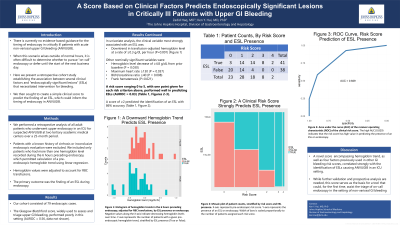Monday Poster Session
Category: GI Bleeding
P2464 - A Score Based on Clinical Factors Predicts Endoscopically Significant Lesions in Critically Ill Patients With Upper GI Bleeding
Monday, October 28, 2024
10:30 AM - 4:00 PM ET
Location: Exhibit Hall E

Has Audio

Zadid Haq, MD
Johns Hopkins University School of Medicine
Baltimore, MD
Presenting Author(s)
Zadid Haq, MD, Ken Hui, MD, PhD
Johns Hopkins University School of Medicine, Baltimore, MD
Introduction: There is currently no evidence-based guidance for the timing of endoscopy in critically ill patients with acute non-variceal upper GI bleeding (ANVUGIB). When this scenario arises outside of normal hours, it is often difficult to determine whether to pursue “on-call” endoscopy or defer until the start of the next business day. Here we present a retrospective cohort study establishing the association between several clinical factors and “endoscopically significant lesions” (ESLs) that necessitated intervention for bleeding. We then sought to create a simple clinical score to predict the finding of an ESL, which could inform the timing of endoscopy in ANVUGIB.
Methods: We performed a retrospective analysis of all adult patients who underwent upper endoscopy in an ICU for suspected ANVUGIB at two tertiary academic medical centers over a 25-month period. Patients with a known history of cirrhosis or inconclusive endoscopic evaluation were excluded. We included only patients who had more than one hemoglobin level recorded during the 6 hours preceding endoscopy, which permitted calculation of a pre-endoscopic hemoglobin trend using linear regression. Hemoglobin values were adjusted to account for PRBC transfusions. The primary outcome was the finding of an ESL during endoscopy.
Results: Our cohort consisted of 79 endoscopic cases. In univariate analysis, the clinical variable most strongly associated with an ESL was a downtrend in transfusion-adjusted hemoglobin level at a rate of ≥0.3 g/dL per hour (P=0.001). Other nominally significant variables were a hemoglobin level decrease of ≥4.8 g/dL from prior baseline (P = 0.030), maximum heart rate ≥130 (P = 0.037), BUN/creatinine ratio ≥40 (P = 0.008) and frank hematemesis (P=0.021). A risk score ranging 0 to 5, with one point given for each risk criterion, performed well in predicting ESLs (AUROC = 0.83). A score of ≥2 predicted the identification of an ESL with 86% accuracy. In contrast, the Glasgow-Blatchford score performed poorly in this setting (AUROC = 0.56).
Discussion: A novel score encompassing hemoglobin trend, as well as four factors previously used in other GI bleeding risk scores, correlated strongly with the identification of ESLs causing ANVUGIB in an ICU setting. While further validation and prospective analysis are needed, this score serves as the basis for a tool that could, for the first time, assist the triage of on-call endoscopy in the setting of non-variceal GI bleeding.
Disclosures:
Zadid Haq, MD, Ken Hui, MD, PhD. P2464 - A Score Based on Clinical Factors Predicts Endoscopically Significant Lesions in Critically Ill Patients With Upper GI Bleeding, ACG 2024 Annual Scientific Meeting Abstracts. Philadelphia, PA: American College of Gastroenterology.
Johns Hopkins University School of Medicine, Baltimore, MD
Introduction: There is currently no evidence-based guidance for the timing of endoscopy in critically ill patients with acute non-variceal upper GI bleeding (ANVUGIB). When this scenario arises outside of normal hours, it is often difficult to determine whether to pursue “on-call” endoscopy or defer until the start of the next business day. Here we present a retrospective cohort study establishing the association between several clinical factors and “endoscopically significant lesions” (ESLs) that necessitated intervention for bleeding. We then sought to create a simple clinical score to predict the finding of an ESL, which could inform the timing of endoscopy in ANVUGIB.
Methods: We performed a retrospective analysis of all adult patients who underwent upper endoscopy in an ICU for suspected ANVUGIB at two tertiary academic medical centers over a 25-month period. Patients with a known history of cirrhosis or inconclusive endoscopic evaluation were excluded. We included only patients who had more than one hemoglobin level recorded during the 6 hours preceding endoscopy, which permitted calculation of a pre-endoscopic hemoglobin trend using linear regression. Hemoglobin values were adjusted to account for PRBC transfusions. The primary outcome was the finding of an ESL during endoscopy.
Results: Our cohort consisted of 79 endoscopic cases. In univariate analysis, the clinical variable most strongly associated with an ESL was a downtrend in transfusion-adjusted hemoglobin level at a rate of ≥0.3 g/dL per hour (P=0.001). Other nominally significant variables were a hemoglobin level decrease of ≥4.8 g/dL from prior baseline (P = 0.030), maximum heart rate ≥130 (P = 0.037), BUN/creatinine ratio ≥40 (P = 0.008) and frank hematemesis (P=0.021). A risk score ranging 0 to 5, with one point given for each risk criterion, performed well in predicting ESLs (AUROC = 0.83). A score of ≥2 predicted the identification of an ESL with 86% accuracy. In contrast, the Glasgow-Blatchford score performed poorly in this setting (AUROC = 0.56).
Discussion: A novel score encompassing hemoglobin trend, as well as four factors previously used in other GI bleeding risk scores, correlated strongly with the identification of ESLs causing ANVUGIB in an ICU setting. While further validation and prospective analysis are needed, this score serves as the basis for a tool that could, for the first time, assist the triage of on-call endoscopy in the setting of non-variceal GI bleeding.
Disclosures:
Zadid Haq indicated no relevant financial relationships.
Ken Hui indicated no relevant financial relationships.
Zadid Haq, MD, Ken Hui, MD, PhD. P2464 - A Score Based on Clinical Factors Predicts Endoscopically Significant Lesions in Critically Ill Patients With Upper GI Bleeding, ACG 2024 Annual Scientific Meeting Abstracts. Philadelphia, PA: American College of Gastroenterology.

